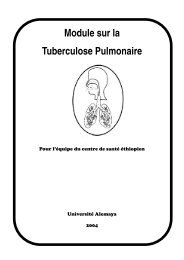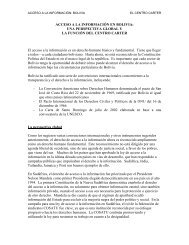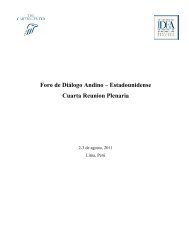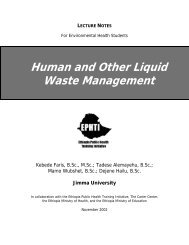Urinalysis - The Carter Center
Urinalysis - The Carter Center
Urinalysis - The Carter Center
You also want an ePaper? Increase the reach of your titles
YUMPU automatically turns print PDFs into web optimized ePapers that Google loves.
Introduction<br />
viii<br />
Examination of urine as an aid to diagnose a number of diseases is the<br />
oldest among tests in the history of Medical Laboratory Technology. It<br />
has been known for centuries that abnormalities in urine may indicate<br />
disease. Perhaps, one of the earliest known record of urine test was the<br />
technique of pouring urine on the ground and observing whether or not it<br />
attracted insects. <strong>The</strong> attraction of insects indicates " honey urine "<br />
which was known to be excreted by people with boils. Today checking<br />
sugar in urine is a test to detect diabetes (And untreated diabetes still<br />
suffer from boils). Around 1000 AD a Persian Physician named Ismail of<br />
Jordan described seven different observations made on urine such as<br />
Urine Consistency, Color, Odor, Transparency, Sediment and Froth. It<br />
was Walter Ames Compton who ushered in the modern era of <strong>Urinalysis</strong><br />
in the early 1940's with the invention of 'CLINITEST'.<br />
<strong>Urinalysis</strong> is a group of tests performed most frequently on random<br />
specimen. It is one of the most helpful indicators of health and<br />
disease, especially, it is useful as a screening test for the detection<br />
of various endocrine or metabolic abnormalities in which the<br />
kidneys function properly but they will excrete abnormal amounts of<br />
metabolic end-products specific of a particular disease. It is also<br />
used to detect intrinsic conditions that may adversely affect the kidneys<br />
or urinary tract. Diseased kidneys cannot function normally in regulating<br />
the volume and composition of body fluids, and in maintaining<br />
homeostasis. Consequently, substances normally retained by a kidney<br />
or excreted in small amounts may appear in the urine in large quantities,<br />
or substances normally excreted may be retained by kidney.<br />
Generally, urinalysis provides useful information concerning the<br />
presence or absence of renal and other diseases, and as a<br />
routine test, it is a very simple method for monitoring the course<br />
of a disease as well as the efficacy of treatment.
















